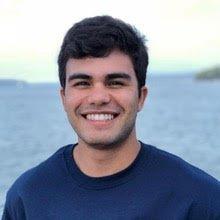
Jake Burstein
Tell us about your work/research. What kinds of things do you do?
I am most interested in using marine geophysics to study the surface and subsurface of the seafloor, also known as seafloor mapping. Knowledge of what lies under the sea can lead to a host of very fun discoveries, from sunken ships and airplanes to deep-sea volcanoes and coral reefs. As a geologist at heart, I especially love to use geophysical subsurface imaging and rock core samples to study the geology of the seafloor. This enables us to act as Earth's historians, and begin to understand how and why certain regions exist as they are today. Currently, at USC, I work as a research assistant at the Earth Sciences and Resources Institute (ESRI-SC). My project involves using seafloor mapping to advise the Bureau of Ocean Energy Management (BOEM) on favorable locations offshore South Carolina for wind energy development. I hope to turn this very demanding, yet very fun project into my senior thesis, and hopefully contribute to the current body of knowledge in a peer-reviewed journal.
What sparked your initial interest in your career?
I came to USC as a geophysics major. Full disclosure: I only chose geophysics because I got in-state tuition from Georgia (my home state) if I chose this major. However, I always knew that I loved nature and that I loved science, so I had a nudge that I might just love geophysics. Yet as I began freshman year, it was geology that first sparked my passion for geoscience. Maybe it was the rocks, maybe it was the amount of time we spent outside, maybe it was my quirky and passionate professor, Dr. Andrew Leier, or maybe it was all these things. Either way, it was game over- I was a rock nerd. As I advanced through my courses, I realized my major, geophysics, is simply (ok, very complicatedly) a tool to observe the geology of subsurface of Earth. This entirely changed how I viewed geophysics and sparked my interest in applying geophysics to study geology.
Who influenced you or encouraged you the most?
All of my professors taught me amazing, mind-boggling ideas about geoscience. However, I would say my instructor for my Structural Geology and Tectonics course, Dr. James Knapp, truly changed how I view both geophysics and geology. He taught us the science behind mountain building. It was here I learned the geologically complicated, yet predictable frameworks of mountains, and how geophysics can be used as a tool to make these observations.
What element of your work/study do you think is the most fascinating?
The most fascinating part of my work is the ability to plan the future of offshore wind energy development for the state of South Carolina. I truly believe we are capable of becoming a sustainable civilization, and I hope my research provides a path to that vision.
What other jobs led you to your current career?
Last summer, I participated in a Research Experience for Undergraduates (REU) internship at the University of Hawaiʻi at Mānoa. Here, I learned to use Geographic Informations Systems (GIS), along with aerial imagery, to track the sea-level rise on the North Shore of O'ahu. This skill qualified me for a job at ESRI-SC the following fall semester, where I use GIS to analyze seafloor mapping data.
What are your degrees and certifications?
Bachelor of Science in Geophysics-- University of South Carolina 2019
What are your hobbies?
I enjoy hiking the beautiful Southern Appalachians. We might not have as great of outcrops as the Rockies, but there are still some pretty sites.
What advice would you give someone who wants to have a career like yours?
My advice for anyone in research would be this: things will always go wrong. When conducting research, things will almost never work out. More times than not, there will be a problem at every step of the way. However, it is important to stay positive, work on one problem at a time, then move onto the next one. Listen to your PI's or mentors and learn to take advice. You might be surprised at how much you will learn through troubleshooting.
How did you get involved with the Nautilus Exploration Program? How did you get on the ship?
I had just started working as a research assistant at ESRI-SC when I left for New Orleans, LA to present past research at the American Geophysical Union Fall Meeting 2017. I stopped by one of the seafloor mapping talks discussing new research on using marine geophysics to study the geology of offshore locations- a subject that I would benefit in becoming familiar with. I noted the organization who conducted the research (OET) with the intention of asking academic questions on how to repeat these studies. Nonetheless, I found an internship opportunity as a seafloor mapper as I browsed the website.
Expeditions
Jake participated in the following Ocean Exploration Trust expeditions:
